Introduction about Vietnam Hill Tribes
Vietnam hill tribes, nestled in the country's remote mountainous regions, offer a stark contrast to the hustle and bustle of urban life. These areas, characterized by their limited agricultural viability, are home to 54 ethnic minority groups, many of which are classified under the broad term "hill tribes."
These communities are scattered across Vietnam, living in territories that span the length of the nation. Each of Vietnam hill tribes boasts its unique language, lifestyle, and heritage, contributing to a rich cultural mosaic that is distinct from mainstream Vietnamese society.
Historically, these groups have been collectively known as Montagnards, a term introduced by the French, meaning "mountain people". Despite their rich cultural heritage, these tribes find themselves on the fringes of Vietnam's rapid modernization efforts.
Efforts by the government to alleviate poverty and improve access to education and other essential services have, regrettably, not fully reached these remote communities, leaving them somewhat isolated from the country's developmental strides.
In light of the promising prospects of tourism, the Vietnamese government has made concerted efforts to encourage the hill tribes to maintain their traditional identities and cultural legacies.
This initiative aims not only to preserve the unique heritage of these communities but also to integrate them into the broader economic development of the country through tourism.
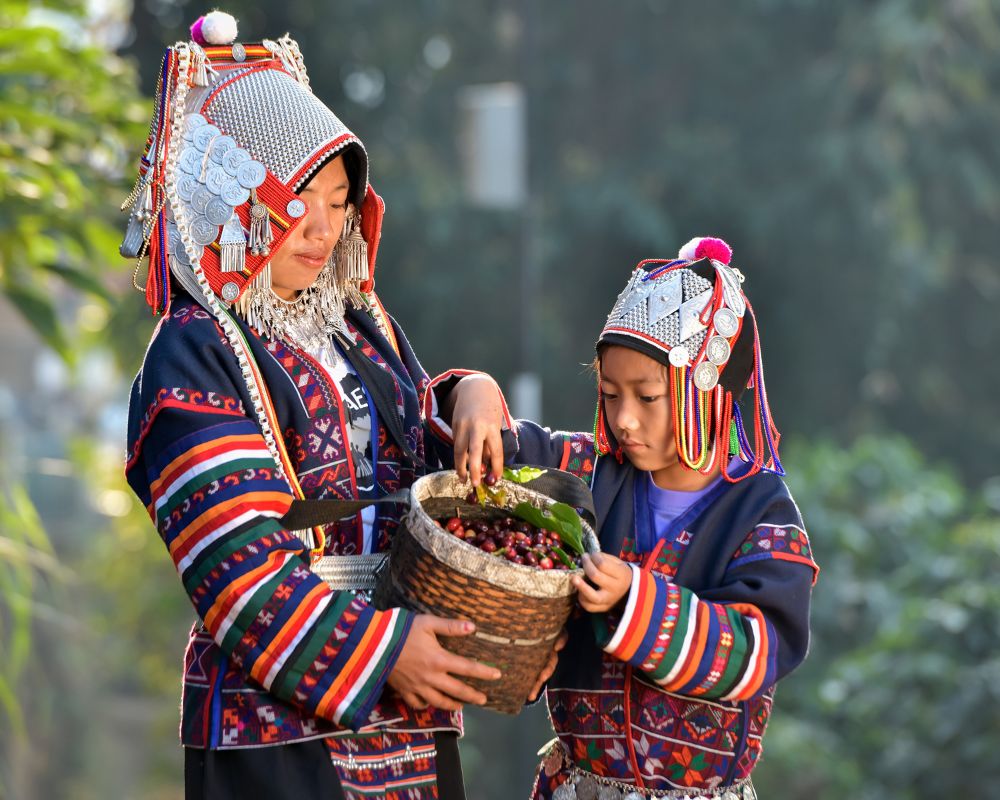
Two mountain people wearing national costumes
Tribes such as the Hmong, Dao, and Tai, residing in the northern highlands, have notably leveraged this opportunity. They have engaged with the burgeoning tourism sector by offering homestay accommodations and selling handmade crafts, thereby creating a niche for themselves within Vietnam's tourist attractions.
However, the central highlands' tribes have not been as prominently featured in tourism offerings. This region, fraught with sensitivity due to historical land disputes and allegations of religious suppression by international human rights organizations, remains less traversed by tourists.
The dichotomy between the government's efforts to modernize and the preservation of tribal traditions presents a complex narrative of cultural preservation amidst rapid national development.
This introduction to the lives of Vietnam hill tribes lays the groundwork for exploring the major groups within the northern highlands, each with its own story of cultural resilience and adaptation in the face of modern challenges.
I. Northern Highlands
1. Nung
The Nung, numbering around 870,000, share a close linguistic, cultural, and customary bond with the Tay. They reside in the northeastern provinces of Cao Bang and Lang Son, areas that border China. This proximity has influenced their culture, yet they've maintained a distinct identity.
The Nung are celebrated for their rich folk art traditions, which encompass music, poetry, and a wide array of handicrafts. These artistic expressions not only serve as a testament to their cultural richness but also play a pivotal role in the preservation of their heritage.
2. Muong
The Muong people, numbering around 1.2 million, reside in the mountainous regions of Hoa Binh and Thanh Hoa provinces. They share a close connection with the Kinh, Vietnam's majority ethnic group.
Unlike the Kinh, who moved to the lowlands and were influenced by Chinese culture following the 11 BC Han invasion, the Muong stayed in the mountains, developing a distinct culture of their own. This separation has allowed them to maintain a unique identity, closely tied to the natural landscape they inhabit.
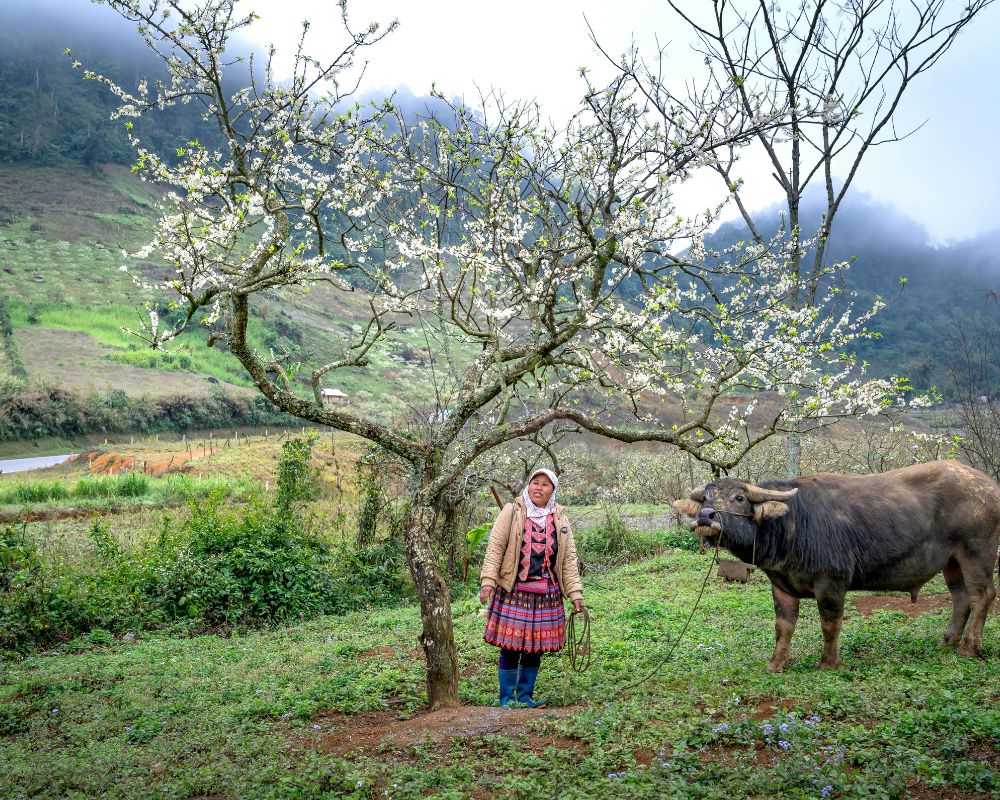
The Muong people with a buffalo
Both the Hmong and Muong peoples contribute richly to Vietnam's cultural tapestry, showcasing unique traditions, skills, and ways of life that have evolved over centuries.
Their stories and crafts, especially in places like Sapa, have become a significant draw for tourists, bringing attention to the beauty and diversity of Vietnam's ethnic minority cultures.
3. Hmong
The Hmong, also known as Meo, are a vibrant community of about 800,000 people living across the northern highlands of Vietnam. Their journey to Vietnam started in the early 19th century, fleeing unrest and warfare from the southern Chinese kingdom of Bach Viet. They settled in areas now known as giao, forming villages that dot the rugged landscape.
The Hmong culture is rich and diverse, with the community divided into various branches. These distinctions are made based on women's clothing, dialect, and customs.
A notable example is the Black Hmong of Sa Pa, distinguished by their predominantly black attire. Another eye-catching group is the Flower Hmong, renowned for their brightly colored clothes and intricate embroidery, especially visible at the Bac Ha market in Lao Cai province.
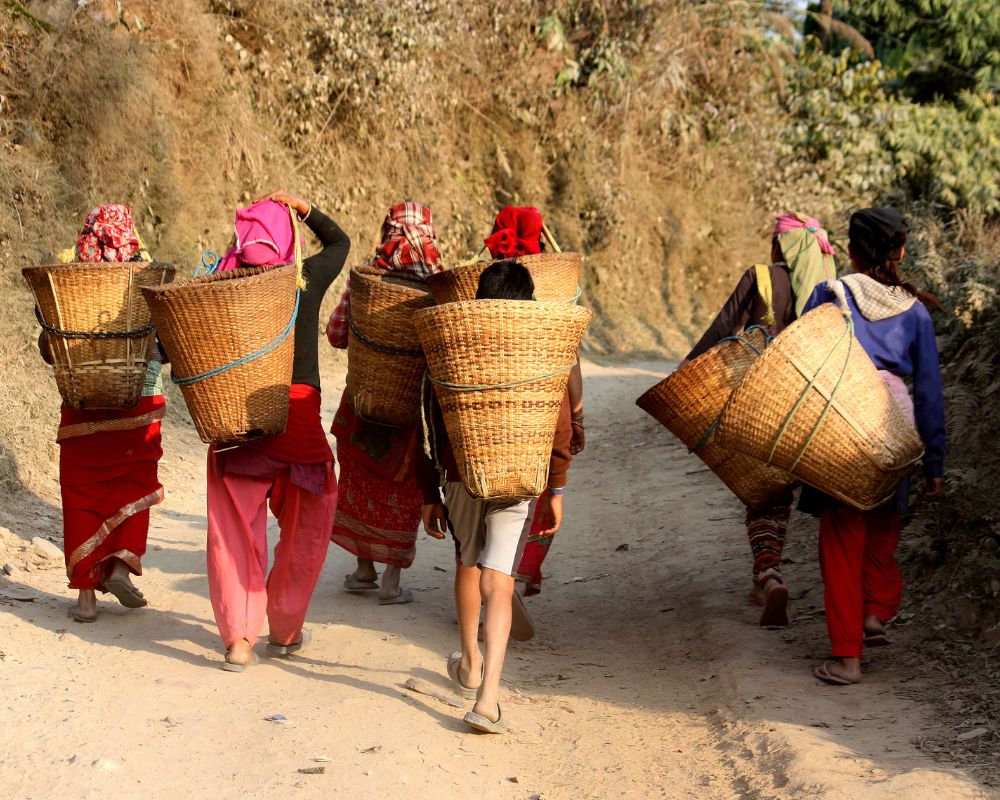
Hmong people carrying baskets on the dirt road
Agriculture plays a central role in Hmong life. Corn is their staple food, though rice is also cultivated on terraced fields, a testament to their adaptation to the mountainous terrain. They also grow hemp and cotton, which are transformed into textiles.
The Hmong are skilled artisans, producing a variety of handicrafts like indigo-dyed cloth, paper, silver jewelry, leather goods, baskets, and embroidery. Their rich oral tradition compensates for the absence of a written language, with legends, songs, folklore, and proverbs passed down orally from one generation to the next.
4. Dao
The Dao people, who say their name as "Zao", came to Vietnam from China way back in the 18th century. They're part of a big group that speaks Hmong-Dao languages and there are about 620,000 of them living in the northern parts of Vietnam.
They've made their homes in both big villages and tiny, out-of-the-way spots where they grow rice by clearing the land with fire, a method known as slash-and-burn agriculture.
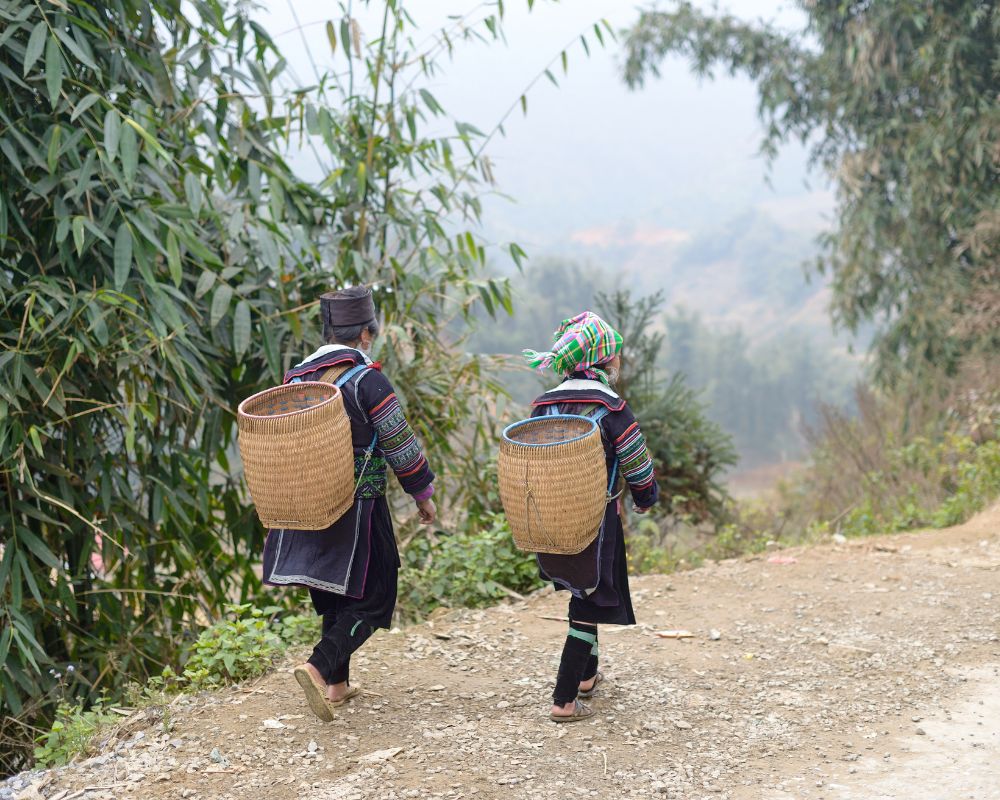
Two Dao girls walking on the mountain road
When you look closer at the Dao, you'll notice they're not all the same. They have different groups among them that you can tell apart by their customs and what the women wear.
For example, some wear white trousers, others prefer long tunics, there are those with shaved heads, and then there are the Red Dao. The Red Dao are especially eye-catching with their bright red turbans decorated with tassels or bells.
Craftsmanship is something the Dao take great pride in, particularly when it comes to making their own paper. They've been doing this for hundreds of years, using it to write down their family histories, songs, and stories, all in Chinese characters.
Cotton is another big part of their life; the women grow it, weave it into fabric, and dye it with indigo. They have this amazing ability to embroider traditional designs onto the fabric straight from memory, making each piece a reflection of their long-held traditions.
In a nutshell, the Dao is a fascinating group with a rich culture, skilled in artistry and deeply connected to their traditions, all while maintaining a strong sense of community across Vietnam's northern landscapes.
5. San Chi
With a population of nearly 150,000, the San Chi live in various provinces such as Ha Giang, Tuyên Quang, and Bac Kan, with some communities in Lao Cai, Yen Bai, and Vinh Phuc. They, too, are part of the broader Tay-Tai language group, having migrated from China in the early 19th century.
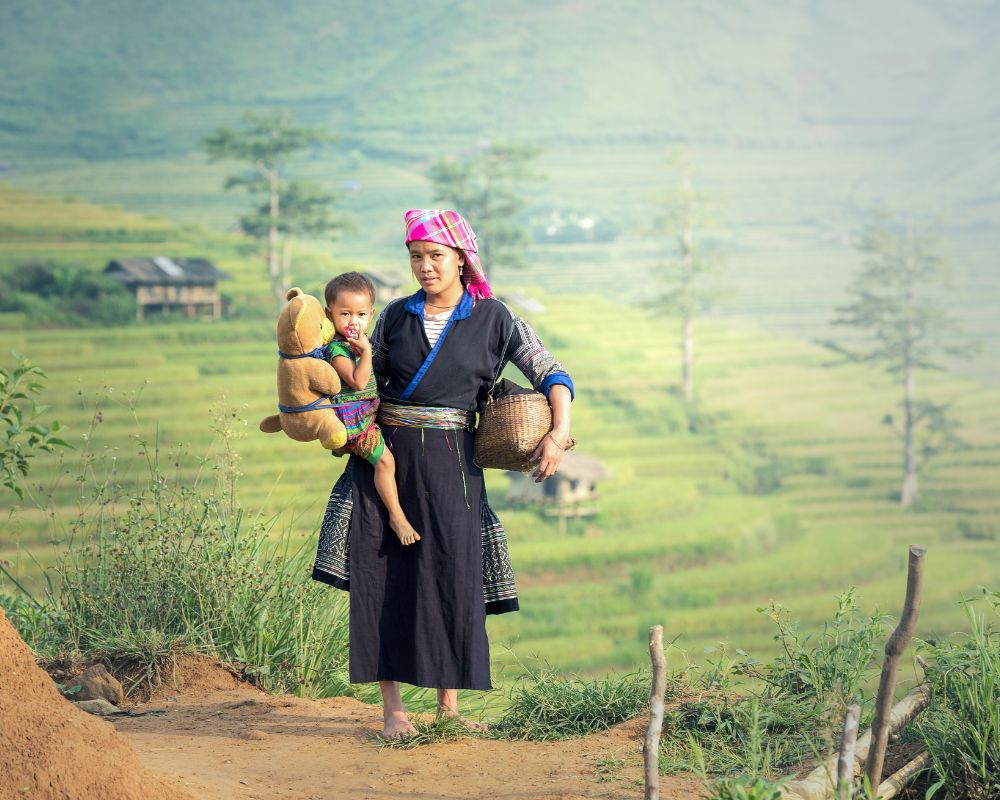
Mother and daughter in rice terraces
The San Chi are known for their elaborate ritual dances, where boys and girls perform traditional love songs in vibrant festivities that can extend throughout the night. This form of expression is a beautiful representation of their communal spirit and social cohesion.
6. Tai
The Tay, forming the largest minority group in northern Vietnam, and the Tai, with over 1.4 million individuals living mainly along the Song Hong (Red River), exemplify the region's ethnic diversity. These communities are deeply rooted in agriculture, cultivating rice, tobacco, spices, and fruits on the rugged mountain terrain.
Despite the pervasive influence of the dominant Kinh culture, the Tay and Tai steadfastly adhere to their indigenous languages and traditions, underscoring a rich cultural identity that coexists with the mainstream.
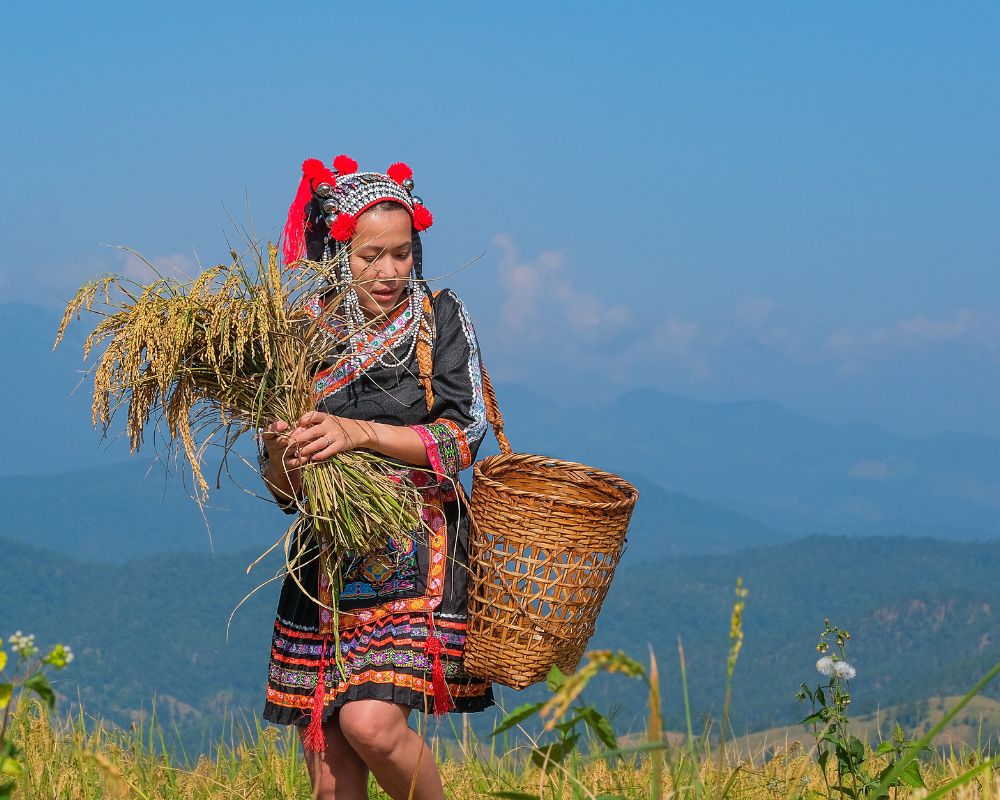
The Tai girl is planting rice
A notable cultural practice among these tribes is the serving of ruou can, a sweet rice liquor, during communal gatherings. This tradition, involving a communal jar and bamboo straws, symbolizes the communal bond and shared heritage that unite these diverse groups.
The rich tapestry of Vietnam's hill tribes, from the Nung to the Tai, paints a vivid picture of a nation steeped in cultural diversity. Their enduring traditions, art forms, and communal practices not only enrich Vietnam's cultural landscape but also offer a window into the lives of communities that have navigated the complexities of preserving their heritage in a rapidly changing world.
7. Tay
The Tay, with a population of approximately 1.5 million, are the largest minority group in Vietnam. They primarily reside in the northern highlands, in provinces like Cao Bang, Lang Son, Bac Kan, Quang Ninh, Ha Giang, and Tuyen Quang, as well as in the Dien Bien Phu region.
Their villages, known locally as ban, are typically situated in valleys near streams or rivers, taking advantage of the fertile land and abundant water supply.
The Tay houses are notable for being built on stilts, using bamboo or wood, which helps protect them from flooding and wild animals. These stilt houses come in two main styles: those of the Black Tai, which are tortoise shell-shaped, and the White Tai, which have rectangular constructions.
Tay women are known for their weaving skills, creating intricate embroidery with motifs that include flowers, birds, animals, and dragons, showcasing their artistic talents and cultural symbols.
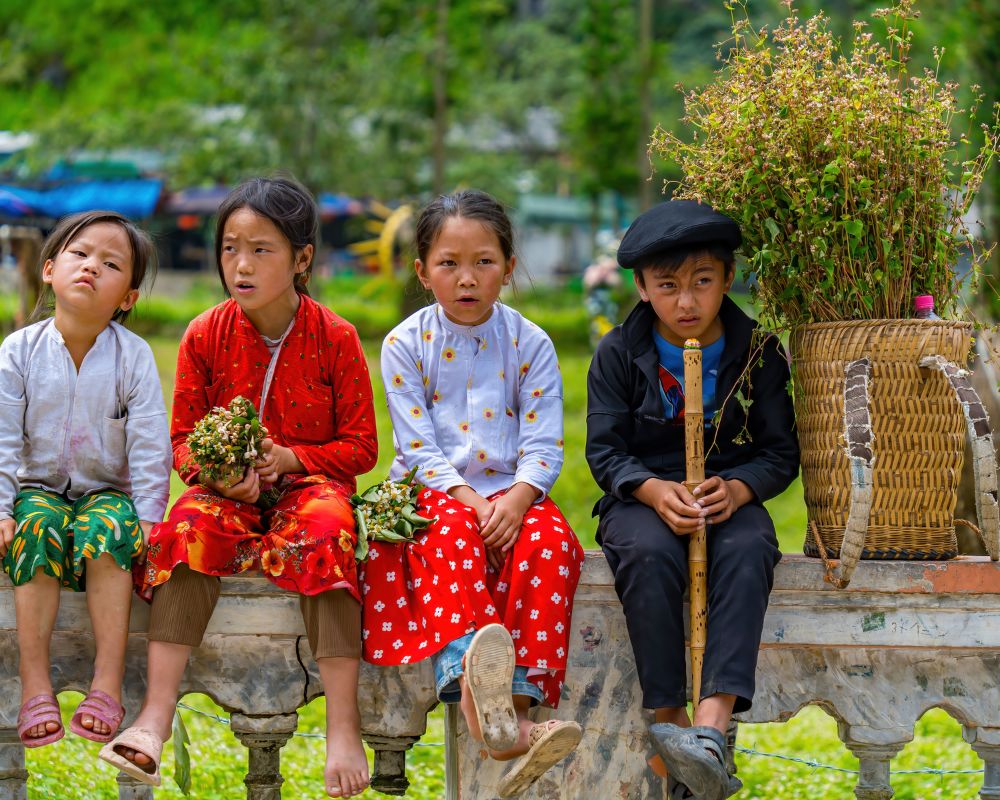
Tai ethnic minority kids at Ha giang
II. Southern & Central Highlands
1. Bahnar
In the central highlands, particularly in the provinces of Gia Lai and Kon Tum, as well as in the coastal regions of Binh Dinh and Phu Yen, live the Bahnar people—one of Vietnam's most economically disadvantaged groups. The Bahnar population numbers around 180,000.
Their society is structured around a traditional calendar that allocates ten months to agricultural activities and the remaining two months to social and personal responsibilities, such as marriages, weaving, ceremonies, and festivals.
A distinctive Bahnar tradition is the ear-piercing ceremony for infants, which occurs when a baby turns one month old. This ritual symbolizes the child's formal acceptance into the community.
According to Bahnar belief, those who pass away without ear piercings are doomed to spend their afterlife in a realm ruled by a black-eared goddess named Duydai, highlighting the cultural significance of this practice.
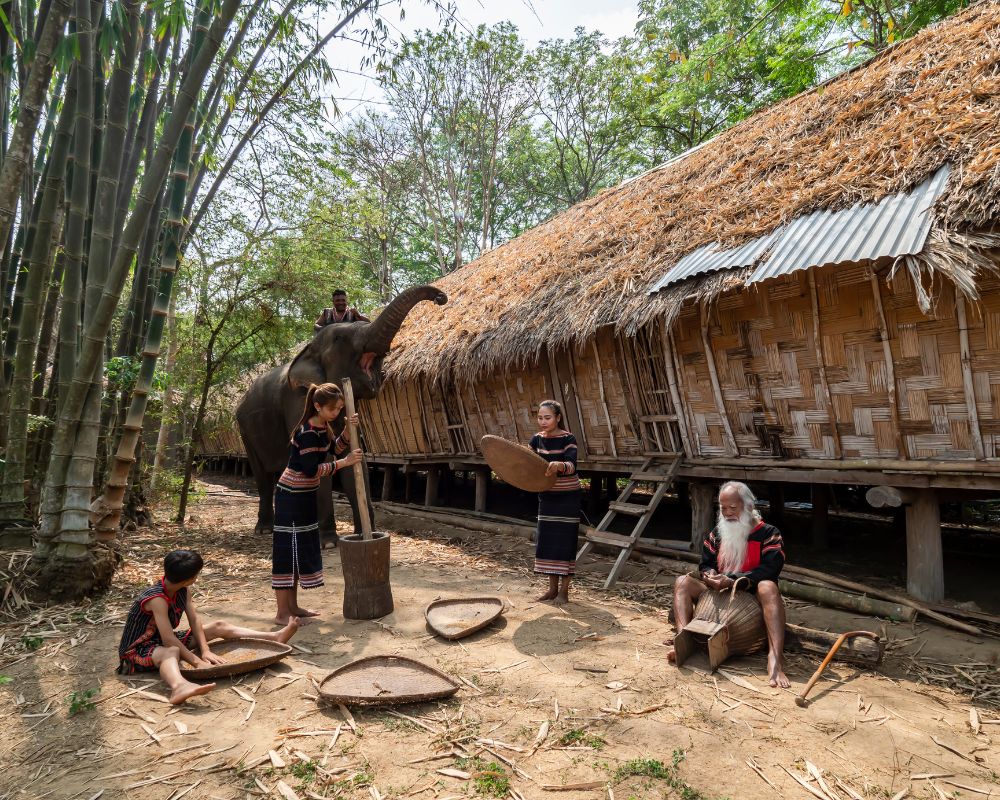
Bahnar family at Tay Nguyen
Both the Tay and Bahnar communities, through their distinct living arrangements, traditional practices, and social customs, contribute to the mosaic of Vietnam's ethnic diversity.
These traditions not only illustrate the unique identities of each group but also their deep-rooted connection to their ancestral lands and the natural world.
2. Jarai (Gia Rai)
The Jarai, numbering around 320,000, reside in the central highland provinces of Gia Lai, Kon Tum, and Dak Lak. As members of the Malay-Polynesian language group, they settled in the Tay Nguyen highlands approximately 2,000 years ago.
The Jarai live in villages called ploi or bon, characterized by at least 50 homes clustered around a nha rong, which serves as the communal house and the center of village life. The Jarai society is organized around small matriarchal families, where women play a significant role in community and family decisions.
Marriage customs among the Jarai are particularly noteworthy. It is the young women who initiate the marriage process through an intermediary.
The engagement is marked by a unique bracelet-exchanging ceremony, which involves three main steps: the exchange of bronze bracelets, the interpretation of the couple's dreams to predict their future together, and the wedding ceremony, typically hosted at the groom's family home. These practices underscore the importance of marriage and family within Jarai culture.
3. Rhade (Ede)
The Rhade, with a population exceeding 270,000, primarily inhabit Dak Lak in the central highlands. Similar to the Jarai, they belong to the Malay-Polynesian language group and live in longhouses built on stilts, known as buon.
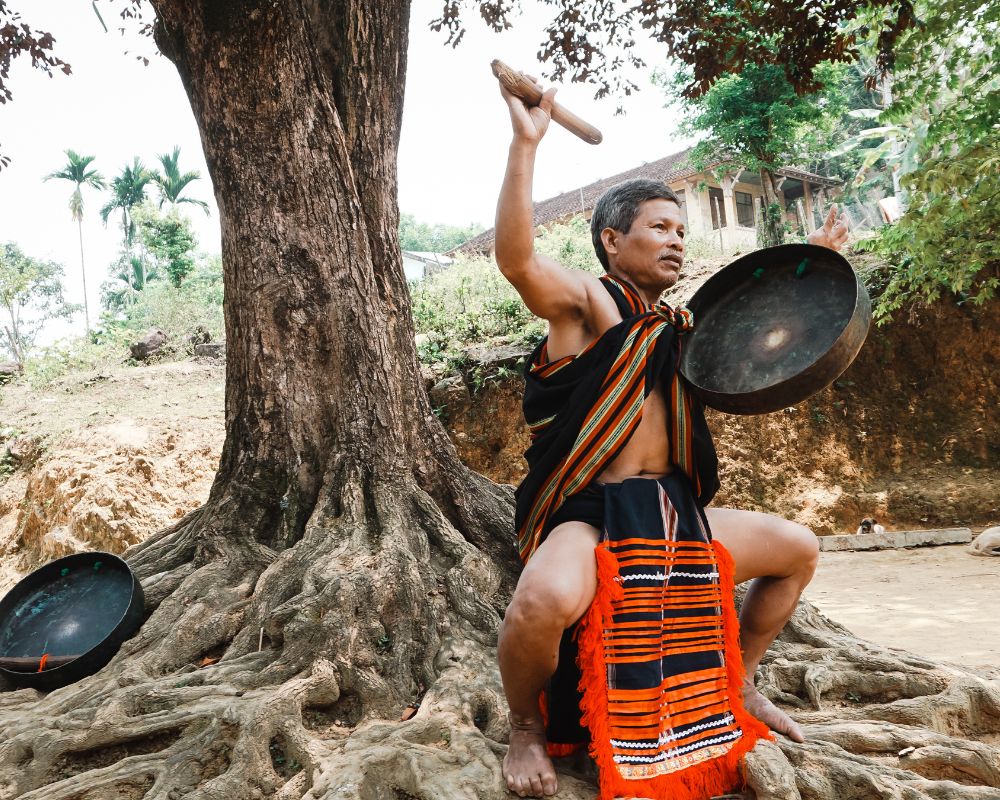
Vietnamese Central Highlands gong artisans person
These longhouses accommodate large matriarchal families led by a senior woman, known as koa, who oversees community affairs and the safeguarding of communal heirlooms, such as bronze gongs and jars used in rice beer preparation for festivals. The village chief, or po pin ea, is elected to manage communal affairs, highlighting a structured social organization within the Rhade community.
Agriculturally, the Rhade practiced slash-and-burn farming, cultivating rice, sugar cane, melons, cotton, and tobacco. Artisanship is also a significant aspect of Rhade culture, with villages often having their forge for metalwork and producing basketry, pottery, and indigo-dyed cloth for personal use.
Both the Jarai and Rhade cultures are vivid examples of Vietnam's ethnic diversity, showcasing distinct traditions, social structures, and connections to their environment. Their marriage customs, matriarchal societies, and agricultural practices offer a window into the enduring legacy and rich cultural tapestry of Vietnam's central highland communities.
4. Lowland minorities
The lowland minorities of Vietnam, including the Khmer Krom, Cham, and Ethnic Chinese, add another layer to the country's rich ethnic mosaic, each group bringing its own unique history, culture, and set of challenges within the Vietnamese socio-political landscape.
Khmer Krom
The Khmer Krom, numbering approximately 1.1 million, are ethnic Cambodians residing in the Mekong Delta region. This group is among the more marginalized communities in Vietnam, facing challenges related to cultural preservation and rights.
There are reports of the Khmer Krom being compelled to speak Vietnamese and adopt Vietnamese names, reflecting the pressures they face in maintaining their cultural identity.
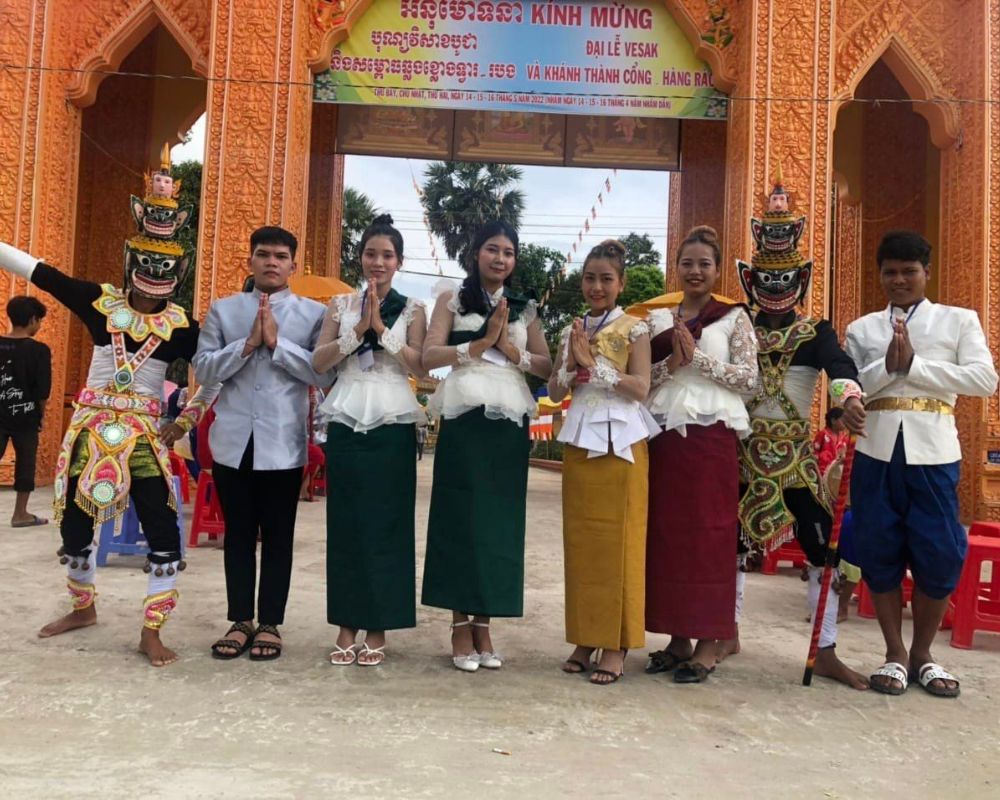
Vesak Festival of Khmer people
Although the government permits the broadcasting of some television programs in Khmer, it's reported that individuals seeking to access Cambodian channels privately may encounter difficulties, highlighting the restrictions placed on their cultural expressions.
Cham
The Cham people, with a population of around 130,000 in Vietnam, are the descendants of the historic Champa Kingdom, which was integrated into the Vietnamese state in the 15th century. This integration marked the beginning of a long history of cultural assimilation and, in some cases, marginalization for the Cham.
Despite these challenges, the Cham have preserved many aspects of their unique culture, including their language, religion, and architectural heritage, showcasing the resilience of their identity.
Ethnic Chinese (Hoa)
The Ethnic Chinese, or Hoa, in Vietnam number some 860,000, making them a significant minority group, primarily concentrated in urban centers. Historically, the Hoa have played a crucial role in Vietnam's economic activities, especially in trade and commerce.
Despite facing various social and political challenges over the years, including periods of tension between Vietnam and China, the Hoa community has managed to maintain its cultural heritage, language, and traditions.
The experiences of these lowland minorities—Khmer Krom, Cham, and Ethnic Chinese—reflect the broader complexities of ethnic diversity within Vietnam.
Each group navigates its own set of challenges in preserving cultural identity and dealing with the pressures of assimilation and modernization. Their stories are an essential part of Vietnam's cultural fabric, contributing to the country's rich diversity and complex history.
